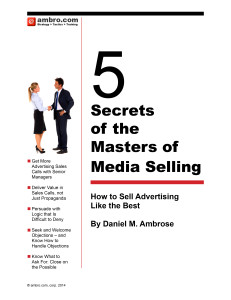Let’s Demolish the Myth that Print is Dead
So much has been written, especially online, about the decline of the print publishing industry. Digital pundits say print is old, print is slow, print isn’t interactive, and print is not green. And yet, it’s well recognized that magazines such as The Economist, which competes in the financial sector with the greatest amount of time-sensitive material, and The Atlantic a doyen of long-form journalism and Vogue on the cutting edge of ‘the new’ are all thriving. How can this be?
This post is intended reveal the fallacies behind the “print is dead” mantra and to outline the sales process for how to sell print advertising more successfully.
Print has not lost the values that make it important to loyal readers in any sector. Print is far more trusted than online, readers love the sense of permanence of print that implies “this article or ad has value.” Readers value the experience of browsing through the pages of a favorite magazine, discovering new ideas and products and services through editorial content and advertising that they would never have searched for in a digital world. This serendipity is central to the value of print and is illustrated by Vogue, which published an all-time-record-ad-pages issue in September.
Why do advertisers and readers like Vogue? It’s the browsing thorough a magazine that presents editorial and advertising together in a comfortable juxtaposition. A magazine or newspaper can present a very large and rich advertising message — a full page — in a way that is not interruptive, but is effective in capturing the attention of the reader if they are interested. And print creates a shared experience that is the essence of social marketing, too, because when I see an article or advertisement in a magazine I know my friends who are readers saw it too.
The Important Back Story on Circulation
Recently the New York Times covered the success of hobbyist magazines using the example of titles like Model Railroader and Wine Spectator. The story attributes these magazines’ success primarily to the loyalty of the subscribers…which is no-doubt true.
However, neither the reporters covering the story, nor the brand-pundit who was quoted, understand the history of magazine and newspaper circulation. Understanding that back-story, and explaining it to advertisers, will help you see, and advertisers see that print is not dying, it is adjusting to a new circulation economics environment.
Right-sizing the Print Publishing Industries
Magazines and newspapers were in a bubble, right along with the dot-com stocks, at the end of the last century and the early part of the new. The bursting of the bubble has made some commentators conclude that print would decline to zero. And the pressures of the recession of 2007-08 excaberated the decline.
However, if we recognize that we were in a bubble of over-circulation of magazines and newspapers, we can better evaluate the changes taking place around us and the adjustment that advertising supported print-publishing is making.
The bubble was caused by a very high growth in advertising spending in the ’80s and ’90s. It was a time when there were not many places (compared to today) for advertisers to spend money and build sales. The markets believed that that advertising would always be there to fund the losses on circulation that was pushed far higher than “normal demand” justified. One feature of this boom was the launch of hundreds of free circulation magazines. I was part of that free circulation boom; selling advertising for Healthy Kids, free in pediatricians offices, when I was at Cahners, and later at the New York Times Women’s Magazines, publishing Having a Baby, The Organized Pregnancy and The Organized Parent; all supported by copious advertising from Procter & Gamble, Johnson and Johnson and the like.
Another example of the over-supply was the launch by almost every paid circulation city magazine of a free ‘bridal’ magazine and/or ‘home & garden’ magazine for their region. In a world where for many years 2 bridal magazines were enough, suddenly there were dozens.
These magazine launches, were done with little to no investment, because advertisers would foot the bill from the beginning. And the circulation auditing authorities had begun to loosen the requirements for blue-ribbon circulation.
The Association of Audited Media, formerly called ABC for Audit Bureau of Circulation, and the BPA (Business Publications Audit) aided and abetted the bubble just as S&P and Moody’s did so with the housing bubble. While S&P labeled bundles of ‘liar-loans’ as triple-A bonds, the ABC loosened its rules on what was required to call a person who received a magazine a legitimate subscriber.
Magazine and newspaper publishers found many ways to expand their circulation beyond the core group of readers who cared deeply about the content. Circulation became too high and too many un-needed magazines were started.
Diluting Quality Circulation
For many years paid-circulation magazines were required by ABC to state their subscription price and they were required to collect no less then half of that subscription price from a customer to count them as a “paid subscriber.” Even then plenty of abuses were countenanced, all in the name of building circulation to deliver value to advertisers. Magazines paid for airline and airport distribution with check swaps so that they could count it as paid circulation. And it was perfectly fine if the promotional costs of convincing someone to subscribe far out-weighed the revenue paid by the subscriber. Magazines routinely lost money on circulation in order to make it up, and then some, on the advertising.
The largest of the circulation-boiler-room techniques was the sweepstakes-stamp-sheet run by Publishers Clearing House. PCH routinely delivered enormous chunks of big magazine circulation that was called “paid” even though the net payment flow was TO PCH, not from the subscriber, through PCH to the magazine. This circulation was called “zero remit” or even “negative remit” circulation obscuring the fact that publishers were paying suppliers to supply names and addresses of people who would pass the ABC audit muster, but who were not interested enough to order the magazine without a lottery ticket to go with it.
PCH was so effective at getting people to order a magazine subscription they didn’t really care very much about, just to improve their chances in the sweepstakes, that they were eventually required to change by the authorities, shutting down a key source of circulation to fill inflated (bubble) rate-bases.
This is when ABC started down the road to easing the rules, making it easier to give away magazines in public places so people would see and read them, but still count them as valid “ABC” circulation. To fill the void, a raft of new circulation “sources” grew to fill rate-bases like drug dealers filling heroin demand.
With so much of a “paid circulation” magazine’s circulation being a cash drain rather than cash collector, it’s no wonder that when advertising went down in the post dot-com recession magazines were hurt. Suddenly the whole magazine business model didn’t work. And the same happened in newspapers. Newspapers pushed ‘paid circulation’ to the limit with free copies in public places, and paid door-to-door sales people more then they collected for the ‘paid’ subscriptions because the advertising from classified and inserts was so high. It didn’t matter if the household didn’t read. Perhaps they looked at the comics while they laid on the couch watching Days of Our Lives. It was circulation that generated a profit from the advertising.
With such lenient auditing rules, and so much demand for circulation to drive advertising revenue, magazines and newspapers expanded their circulation far beyond the “natural level” of those who wanted the whole product and were willing to pay a fair price for it. As advertising fell, so necessarily, too, did circulation. With less advertising to support circulation to readers who didn’t care much or pay much, magazine and newspaper circulation began to drop. And the digital industry pundits began to say print is dead. It was the same logic that might of lead analysts to predict that people would no longer live in houses after the popping of the housing bubble.
How to Sell Print Advertising
Once you can see that print circulations will be smaller, but not extinct, you can set the stage to explain to advertisers the values of print. Print reaches potential customers who are committed to the subject. Print engages those readers because they trust the content and trust the editors to have selected material to publish that they will be interested in. Print readers like the unexpected; learning about something they didn’t know they needed to know. They find browsing through a magazine to be a pleasurable time of dreaming about and learning about their passion and seeing advertisements that complement their interests and lifestyle that are presented in a way that is natural, not intrusive and interruptive.
The right way to sell print advertising is to first propose and achieve agreement with advertisers about their needs. You must discuss the advertisers need in such an intelligent way that they agree with your “premise” that is required to convince them that the logically will lead to their need for print advertising in an newspaper or magazine. Before you can sell print you must get the customer to agree they need the values delivered by print; to build awareness and trust with prospects before they attempt to promote a transaction.
Will an advertisers’ prospective customer be willing to click a small rectangle ad online to learn more about or buy a product that they don’t know much about? Not likely. But if they have become aware of and interested in the company and the product through print, then they are far more likely to respond to an online advertisement they see later. Print builds that awareness and trust, because a large and sophisticated and engaging impression — a full-page 4-color ad — can be delivered very effectively in print in a way that is impossible online.
Many heavily advertised categories of products and services are high-trust sectors. Think of financial services, healthcare, transportation, and food. These are all areas where trust is an important component of any transaction. Gum and beer not so much. Advertisers who use print can then tap the trust they have previously built with print by doing digital advertising.


Pingback: More Proof of the Value of Print Advertising | ambro.com
See the next post as well with data to back up the claim that print is superior to digital in important respects.
Dan
Pingback: It Was a Print-Bubble in the 1990's and Early 2000's | ambro.com